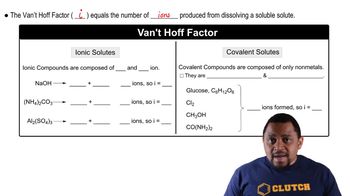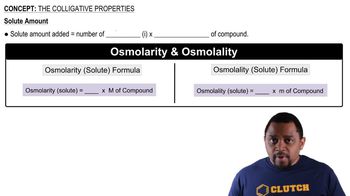Here are the essential concepts you must grasp in order to answer the question correctly.
van't Hoff Factor (i)
The van't Hoff factor (i) represents the number of particles into which a solute dissociates in solution. For ionic compounds like LiCl, which dissociates into Li+ and Cl-, the van't Hoff factor is typically greater than 1. In this case, an i of 1.96 indicates that the solute behaves as if it produces nearly two particles in solution, affecting colligative properties such as vapor pressure.
Recommended video:
Colligative Properties
Colligative properties are properties of solutions that depend on the number of solute particles rather than their identity. These include vapor pressure lowering, boiling point elevation, freezing point depression, and osmotic pressure. The extent of vapor pressure depression can be calculated using Raoult's Law, which states that the vapor pressure of a solvent is directly proportional to the mole fraction of the solvent in the solution.
Recommended video:
Raoult's Law
Raoult's Law states that the vapor pressure of a solvent in a solution is equal to the vapor pressure of the pure solvent multiplied by the mole fraction of the solvent in the solution. When a non-volatile solute is added, the vapor pressure decreases, and this decrease can be calculated using the formula ΔP = i * P° * X_solute, where ΔP is the change in vapor pressure, P° is the vapor pressure of the pure solvent, and X_solute is the mole fraction of the solute.
Recommended video:
Raoult's Law and Vapor Pressure




